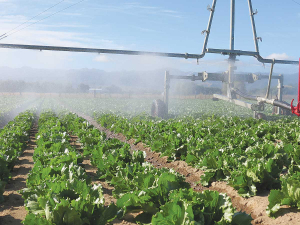Santa's present for the primary sector - an FTA with India
Primary sector leaders have welcomed the announcement of a Free Trade Agreement between India and New Zealand.
 Farm Environment Plans (FEPs) are now recognised in legislation as a way for growers to assess their environmental risks and take action in regards to areas like irrigation.
Farm Environment Plans (FEPs) are now recognised in legislation as a way for growers to assess their environmental risks and take action in regards to areas like irrigation.
Farm Environment Plans (FEPs) are now recognised in legislation as a way for growers to assess their environmental risks, act where required and demonstrate progress on environmental objectives.
The objective of FEPs is to minimise the impact of horticulture and farming on the ecological health and amenity value of New Zealand’s waterways.
In addition to farm maps, an FEP includes the following management areas:
• Soil
• Nutrients
• Irrigation
• Waterways
• Biodiversity
In the near future, agricultural emissions (e.g. nitrous oxide from fertiliser use) are also likely to be included in FEPs to support growers with meeting the Zero Carbon Act 2019 and He Waka Eke Noa (a primary sector partnership to reduce on-farm agricultural emissions).
Growers and the horticulture industry are already very familiar with Good Agricultural Practice (GAP). An FEP is essentially an extension to this existing assurance system.
The primary focus of NZGAP and GLOBALG.A.P. certification is food safety risk assessment and management. While there are elements of environmental management in these standards, they do not currently meet the extensive New Zealand regulatory expectations for FEP content and implementation.
As a result, NZGAP has developed the Environment Management System (EMS) add-on with the purpose of supporting growers to meet regulatory expectations for an FEP as an extension to their existing GAP system.
The Good Management Practices (minimum requirements) and Best Management Practice (aspirational environmental outcomes) identified in the EMS are incorporated from relevant industry guidelines and Codes of Practice, which have been developed from evidence-based research and have been tested with New Zealand growing systems.
In a similar way to how NZGAP is benchmarked to and recognised by GLOBALG.A.P. and the Food Act 2014, the EMS add-on has been benchmarked to regional and national FEP requirements and is already formally recognised by Environment Canterbury.
This means that growers can meet multiple market and regulatory outcomes via the one NZGAP integrated assurance system. NZGAP is now seeking to integrate data from the development and implementation of FEPs into reports for growers, catchment groups and industry bodies to support telling of the horticulture story via our ‘joining the dots’ framework.
For more information on FEPs and the EMS: visit www.nzgap.co.nz
• Damien Farrelly – NZGAP and food safety manager at Horticulture New Zealand.
Ravensdown has announced a collaboration with Kiwi icon, Footrot Flats in an effort to bring humour, heart, and connection to the forefront of the farming sector.
Forest & Bird's Kiwi Conservation Club is inviting New Zealanders of all ages to embrace the outdoors with its Summer Adventure Challenges.
Grace Su, a recent optometry graduate from the University of Auckland, is moving to Tauranga to start work in a practice where she worked while participating in the university's Rural Health Interprofessional Programme (RHIP).
Two farmers and two farming companies were recently convicted and fined a total of $108,000 for environmental offending.
According to Ravensdown's most recent Market Outlook report, a combination of geopolitical movements and volatile market responses are impacting the global fertiliser landscape.
Environment Canterbury, alongside industry partners and a group of farmers, is encouraging farmers to consider composting as an environmentally friendly alternative to offal pits.

OPINION: The release of the Natural Environment Bill and Planning Bill to replace the Resource Management Act is a red-letter day…
OPINION: Federated Farmers has launched a new campaign, swapping ‘The Twelve Days of Christmas’ for ‘The Twelve Pests of Christmas’ to…